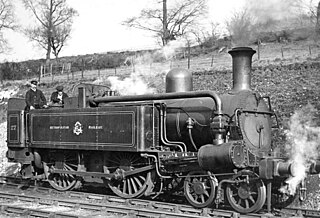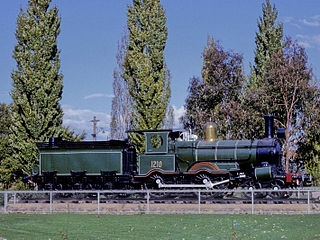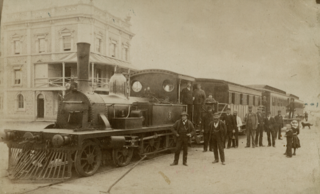
The Metropolitan Railway A Class and B Class were 4-4-0T condensing steam locomotives built for the Metropolitan Railway by Beyer Peacock, first used in 1864. A total of 40 A Class and 26 of the slightly different B Class were delivered by 1885. Used underground, the locomotives condensed their steam, and coke or smokeless coal was burnt to reduce the smoke.
Under the Whyte notation for the classification of steam locomotives by wheel arrangement, a 4-8-2+2-8-4 is a Garratt articulated locomotive consisting of a pair of 4-8-2 engine units back to back, with the boiler and cab suspended between them. The 4-8-2 wheel arrangement has four leading wheels on two axles, usually in a leading bogie, eight powered and coupled driving wheels on four axles and two trailing wheels on one axle, usually in a trailing truck. Since the 4-8-2 type is generally known as a Mountain, the corresponding Garratt type is usually known as a Double Mountain.

The C30 class was a class of steam locomotives built by Beyer, Peacock and Company and Eveleigh Railway Workshops for the New South Wales Government Railways of Australia.

Locomotive 1210 is one of the oldest operational "mainline" steam locomotives in the world being one of the "Australian eight wheeler" locomotives built by Beyer, Peacock & Co. in 1878. It was restored and hauled heritage trains operated by the ARHS ACT Division for many years.

The South Australian Railways P class was a class of 2-4-0T steam locomotives operated by the South Australian Railways.

The South Australian Railways J class was a class of 0-6-0 steam locomotives operated by the South Australian Railways.

The South Australian Railways E class was a class of 2-4-0 steam locomotives acquired to work passenger and goods train services on the South Australian Railways broad gauge system.

The South Australian Railways C Class Locomotives were built by the Robert Stephenson and Company for the South Australian Railways in 1856. The first locomotive numbered 5 was in service by November 1856, the second locomotive numbered 6 was in service by January 1857. They spent many years with the South Australian Railways and were both rebuilt over the years. They were both withdrawn from service after having a number of years on their service record with No. 5 being withdrawn after 50 years worth of service for the SAR. No. 6 lasted well into Commissioner Webbs era, after being withdrawn in 1926 with almost 70 years of service for the SAR.

The South Australian Railways G Class Locomotives first appeared on the South Australian Railways in 1869 after being purchased from Beyer, Peacock and Company. More locomotives were purchased and were in service in 1880, then again followed in 1886. The G class lasted up to 1923 until they were all condemned.

The South Australian Railways Ga Class Locomotive was built in 1874 by Robert Stephenson and Company for the Adelaide Glenelg & Suburban Railway Company and entered service as No. 3. In November 1881 this locomotive was sold to the Glenelg Railway Company and became their No. 3. On the 16th of December 1899 this locomotive entered service on the South Australian Railways as Ga class No. 157, following the SAR purchasing the Glenelg Railway Company. Ga class No. 157 was rebuilt at Islington Railway Workshops in November 1902 and condemned in May 1915. Seven years later this locomotives was scrapped in 1922.

The South Australian Railways Gb Class Locomotives entered service with the South Australian Railways on the 16th of December 1899 following the purchase of the Glenelg Railway Company by the SAR. These locomotives were built by Robert Stephenson and Company in 1874 and 1878. The locomotive built in 1874 enter service on the Adelaide Glenelg & Suburban Railway Company as No. 4. No. 4 was sold to the Glenelg Railway Company in November 1881 and became their No. 4. The locomotive built in 1878 entered service on the Adelaide Glenelg & Suburban Railway Company as No. 5, it was then sold to the Glenelg Railway Company and became their No. 5. They were classed Gb when the SAR purchased the Glenelg Railway Company in 1899 and got renumbered 158 and 159. No. 158 was condemned as of the 12th of December 1904. No. 159 on the other hand a longer career being withdrawn on the 21st of February 1916, then being condemned in December 1921 and ultimately scrapped in 1922.
The South Australian Railways Gc Class Locomotive originally entered service in 1879 on the Adelaide Glenelg & Suburban Railway as No. 6 and was built by Robert Stephenson and Company. In November 1881 the locomotive was sold to the Glenelg Railway Company and became their No. 6. On the 16th of December 1899 it entered service on the South Australian Railways following the purchase of the Glenelg Railway Company. The SAR classed this locomotive as Gc and numbered it 160. Gc class No. 160 was then condemned on the 26th of July 1905.
The South Australian Railways Gd Class Locomotives were built by Beyer, Peacock and Company for service on the Holdfast Bay railway line in 1880. They were numbered 4 and 5. In November 1881 numbers 4 and 5 were sold to the Glenelg Railway Company and became their number 9 and 10. On the 16th of December 1899 these locomotives entered service on the South Australian Railways following the purchase of the Glenelg Railway Company. These locomotives were now classed Gd and were numbered 163 and 164. Ge class No. 163 and No. 164 were both condemned as of the 6th of February 1925 and then eventually scrapped.

The South Australian Railways Ge Class Locomotives were built by Beyer, Peacock and Company for the Glenelg Railway Company in 1897. They entered service as numbers 11 and 12. On the 16th of December 1899 they entered service on the South Australian Railways after the purchase of the Glenelg Railway Company in 1899. The SAR classed these locomotives a Ge and numbered them 165 and 166. Ge class No. 166 was condemned on the 8th of April 1929 and Ge class No. 165 was condemned on the 4th of June 1935. They were both eventually scrapped.

The South Australian Railways H Class Locomotives were built by Robert Stephenson and Company in 1870 for the South Australian Railways. The first of three numbered 25, 26 and 27 were all in service by June 1871. After being a well received class two more locomotives were ordered and were in service by October 1872, these were numbered 28 and 29. In August 1874 and two H class locomotives arrived numbered 30 and 31. The final two locomotives ordered for the SAR arrived in August 1877 and were numbered 2nd 2 and 2nd 3. These locomotives worked on the SAR system for many years with one member of the class being withdrawn as early as 1888. The rest of the class were rebuilt over the years and lasted well into the next century with the final locomotive being withdrawn by 1930.

The South Australian Railways I Class Locomotive was originally built by Neilson and Company, Scotland for the Canterbury Provincial Railways, New Zealand in 1873 and numbered 9. In May 1878 the South Australian Railways purchased this locomotive and it was loaded on the ship "Hyderabad", but was wrecked off New Zealand prior to delivery. The locomotive was salvaged and sent to Port Adelaide, it eventually entered service on the SAR on the 15th of April 1879. Between the years 1880-1881 it was renumbered 48 and between the years 1887-1888 it was classed as "I". In October 1905 it was withdrawn from service with the SAR but in May 1906 it was sold to the South Australian Harbour Board and was used in the construction of the Outer Harbour Breakwater. This locomotive was then condemned in August 1909 and eventually scrapped.

The South Australian Railways L Class Locomotives were built by Beyer, Peacock and Company for the South Australian Railways and were introduced to the system in 1880.

The South Australian Railways M Class (1st) Locomotives were built by Avonside Engine Company from 1868 to 1874. They were originally built for the Canterbury Provincial Railways in New Zealand. They were sent from New Zealand to South Australia in 1878 and were first in service on the South Australian Railways between 1880 and 1881.

















